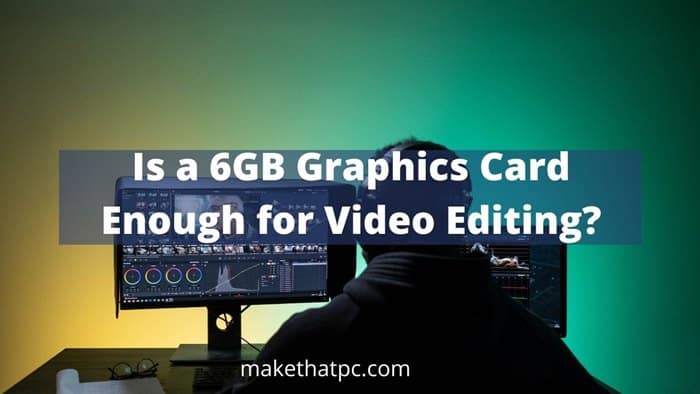With the splurge of video content on YouTube and other media platforms, it’s a no-brainer that the need for the hour is an intuitive video editing application. Be it videos on YouTube or on any other OTT platforms, good video editing calls for enough RAM and a reliable graphics card indeed.
With that said, everything is based on the foundation. If we do not have the setup to curate a good video and export it at high resolution, all your skills may go in vain. So, to understand further, let’s dig deeper!
You can edit 1080P videos with a 6GB Graphics card. You can even edit 2160P footage if 6GB VRAM is fast and your RAM and CPU are powerful. For 4K editing, 6GB is not enough in most cases. Now, the editing performance will depend on the total size of the files. However, your CPU and system RAM will have an important role in improving video editing performance. GPU memory can help with editing but only when you want to add some special effects. Normally, video editing is a CPU-intensive task.

Who regulates the graphics?
Video editing is CPU-intensive work but GPU will help you a lot when it comes to adding some special features. It may sound very easy and undemanding, provided we have many free or cheap applications in the market. However, it is exclusively dependent on how much your laptop or PC can handle.
For the record, the video components are regulated mainly through the graphics card of our system. And, to be very specific, the VRAM or Video Random Access Memory regulates all the media and gaming-related artifacts. To say the least, it is the graphics card that is in charge of the video that you are editing for the upcoming youtube upload!
How much RAM do we need to edit videos?
Editing videos and expecting a good output are two different books in the same library. But, how come?
The RAM on your computer greatly signifies how efficiently and smoothly you can edit a video. Video editing requires the work of a fortune, so no one would want to make it more complex by investing in a poor RAM that does not meet the need. A better RAM coupled with a better Graphics card with a robust support system from the VRAM will let you sail through the experience seamlessly, without any major roadblocks.
What does resolution mean in videos?
We all have a hunch that the FPS is the brain here. FPS, also known as Frames per second, is used to measure the number of frames displayed in a second on your system screen. A high FPS usually means that we get to experience better and smooth videos on our monitor or maybe on the laptop while gaming.
The other Jack in this trade is the resolution. Have you seen that there are multiple resolution settings in a youtube video showing 144p, 1080p, or 4K? You definitely must have! This is known as the resolution. The resolution, in turn, depends on pixels.
To put it simply, Pixels are like the pieces of a jig-saw puzzle, which when put one after the after in the correct order complete a full-blown scape. Resolution depicts the number of pixels displayed on the screen at a time horizontally and vertically. So, the more the number of pixels better is the resolution. And, as the resolution increases, the picture or the frames in a video get sharper and clearer, providing us with a more amazing viewing experience.
In case you are wondering
What is the job of resolution in video editing?
On the surface, video editing may seem to be the work of just adjusting the brightness, contrast, color correct a bit, and some alike business. On the flip side, it has a lot on its plate. Even if we edit a video with all the known effects and transitions, if the resolution is less, the whole work is in vain. It is like a whole meat feast with no seasoning. So, to maintain quality, you got to take care of the resolution.
What are the specifications for a good video editing setup?
In case you are worried about how to make work with a less mounted graphics card, we are here to hook you up with some tips & tricks.
No matter if you are a professional editor or just starting out, some things are better not looked down upon. With that said, the quality of video produced will always be directly proportional to the quality of hardware present in its setup. So, let’s have a look at some of the pointers, shall we?
- First things first, it is the RAM. Even a very good graphics card will not function to its fullest capabilities with less RAM or secondary internal storage. The overall efficiency of a laptop depends on the RAM and storage. Even if you have overloaded storage, try and consider switching some files to make some extra space so that the laptop can optimize its functions. At least 8 GB RAM is recommended for editing 1080p videos and a 16 GB RAM for the 4K lords.
- It is important to have a fairly new processor, preferably an i7 or i9 onboard to be updated with the specifications of your computer. Having 4 or more cores are good. However, you should check the system requirements of your desired video editing software in order to make the right decision. Each software will need difference CPU specifications.
- Screen size greatly influences the resolution you may want to work on. Just as it is nearly impossible to create 4K resolution videos from your phone screen. We recommend you use a 19-22 inch screen to accommodate the pixels properly so that you can perceive them well.
- At least a 256 GB hard drive would work well, to say the least.
- Make sure no other applications are running in the background.
- Own a worthy video editing software. There are quite a few software that are so troublesome in themselves that working on them may seem like one hell of a task. so, choose your software wisely. Some recommended ones are –
- Filmora (for beginners)
- Adobe Premiere Pro
- Lightworks
- Vegas Pro.
- Keep your laptop at an optimum temperature. Nowadays most laptops have a feature where it automatically shuts down when it reaches overheating state. This may turn out to be very annoying while editing and may even not save the edits that you have already made.
Final Verdict
So, the clear answer is YES! 6 Gigs VRAM is more than ideal for editing videos in 4K. However, you should focus on the RAM as well because the system memory will have a lot of impact on editing performance. Also, the graphics card alone is not responsible for video editing. So, first, focus on having a good CPU as well.
With that said, we presume that you have a decent RAM, and an efficiently working graphics card with a reliable VRAM to work in the first place. Well, we hope that we could satisfy your curiosity with all possible explanations.
Stay tuned for more updates like this! Thanks for sticking around….

I am Anshul Rana, an experienced author specializing in PC gear reviews and Windows 10 software tutorials. With a strong passion for technology and an in-depth understanding of the PC industry, I provide insightful and detailed analyses of computer peripherals, gaming gear, and software solutions. My writing style is concise yet informative, making complex topics accessible to both beginners and advanced users. Through my reviews and tutorials, I aim to offer valuable guidance, helping readers make informed decisions to enhance their PC experience and explore the vast possibilities of Windows 10 software.









